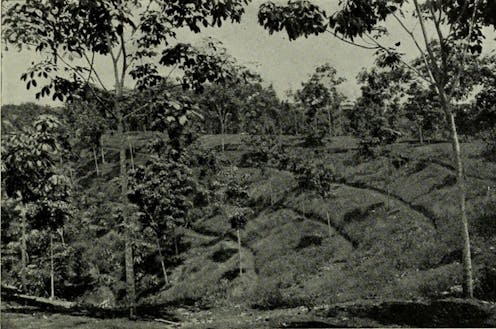How ongoing deforestation is rooted in colonialism and its management practices

Half of the world’s forests were destroyed during the 20th century, with three regions mainly affected: South America, West Africa and Southeast Asia. The situation has worsened to the point that, in 2023, the European Parliament voted to ban the import of chocolate, coffee, palm oil and rubber linked to deforestation.

A weekly e-mail in English featuring expertise from scholars and researchers. It provides an introduction to the diversity of research coming out of the continent and considers some of the key issues facing European countries. Get the newsletter!
A long-standing dependence on raw materials
These products are at the heart of our economies and consumption habits. The case of rubber is particularly emblematic. Without this material, there would be no tyres and, thus, no cars, bicycles, sealing joints or submarine communication cables. Industrial rubber production depends on extracting latex, a natural substance that rubber trees such as hevea produce. Under pressure from corporations and states, Brussels last October announced a one-year postponement of its law regulating rubber imports.
This dependence on the rubber industry is not new. Rubber was central to the second industrial revolution, especially with the rise of automobiles and new management methods. While this history often centres on factories, citing contributions from figures such as Frederick Taylor and Henry Ford and industrial giants like Michelin, its colonial roots are less well known.
Indeed, rubber – like the other resources mentioned above – has been and continues to be primarily produced in former colonial territories. In many cases, rubber trees are not native to the regions where they have been cultivated. Rubber seeds from South America, where latex was already extracted by picking, were transported by colonists to empires for the development of plantations. In particular, the French colonial empire, spanning Africa and Southeast Asia, saw a significant expansion of hevea plantations at the expense of primary forests. Monocultures of rubber trees replaced thousands of hectares.
Ford in the Amazon, Michelin in present-day Vietnam
This management model was favoured because it allowed for lower extraction costs from the coloniser’s perspective. For example, in 1928, Henry Ford negotiated an agreement with the Brazilian government granting him a 10,000 km2 concession of forest land to establish Fordlandia, a settlement designed to produce the rubber needed for his factories. However, this industrial utopia in the Amazon failed due to resistance from Indigenous people and a fungal disease that ruined the plantations.
Following the same model, Michelin invested in plantations in present-day Vietnam as early as 1917. The plantation model and new management methods reduced the cost of rubber production and accelerated its global distribution. These management practices spread across the British, Dutch and French empires, becoming dominant in Southeast Asia in the early 20th century at the expense of primary forests.
À lire aussi :
Allowing forests to regrow and regenerate is a great way to restore habitat
The ‘Taylorization’ of work and nature
Rubber plantations resulted from applying Taylorism not only to workers – especially colonised workers – but also to nature. Both people and trees were subjected to a so-called “scientific” organisation of labour. In our article, L’arbre qui gâche la forêt The Tree That Spoils the Forest, published in the Revue française de gestion (French Journal of Management) in 2024, we analysed historical archives, including a variety of newspapers from 1900 to 1950, covering national, local, colonial and thematic (scientific, cultural, etc.) perspectives. We show that this organisational model is based on an accounting undervaluation of indigenous people’s labour and of nature. This undervaluation is embodied in the metric of the cost price (i.e. the total cost of production and distribution) and in the shared concern to see it lowered. “Ultimately, it’s the cost price that must determine the fate of rubber,” stated the newspaper L’Information financière, économique et politique on February 1, 1914.
In the eyes of some, Asians who were labelled as “coolies” and Brazilian “seringueiros” comprised a low-cost labour pool, with no mention of their working conditions and despite very high mortality rates. “Coolie” is a derogatory colonial term that refers to agricultural labourers of Asian heritage, while “seringueiros” refers to workers in South American rubber plantations.
“By the way, in the Far East, there are reservoirs of labour (Java Island, English Indies), which supply plantations with workers who, while not the most robust, provide regular work at a very advantageous cost price.” (L’Information financière, économique et politique, November 11, 1922)
Concerning trees, only the plantation costs were considered, silencing the human and ecological costs of primary forest destruction.
“In the first year, some 237 francs will have to be spent on the clearing itself; then the planting, with staking […] and weeding, will represent an expense of 356 francs. […] For the following years, all that remains to be done is to consider the maintenance costs, cleaning, pruning, care, supply of stakes, replacement, etc. This will result in an expenditure of 1,250 francs for the first five years.” (L’Information financière, économique et politique, January 31, 1912)
The ‘Cheapization’ of life
The focus on cost price leads to standardisation of management practices by aligning with what is cheapest, at the expense of ever more intense exploitation of human and non-human workers. In other words, these assumptions about the construction of accounting metrics and the circulation of these metrics play a role in the “cheapization” of human and non-human labour. We borrow the concept of “cheapization” from the environmental historian Jason W. Moore. In his view, the development of capitalism is marked by a “cheapization of Nature”, which includes, within the circuits of capitalist production and consumption, humans and non-humans whose work does not initially have a market value. Living beings are thus transformed into a commodity or factor of production: “animals, soils, forests and all kinds of extra-human nature” are being put to work.
À lire aussi :
What actually makes avocados bad for the environment?
Why does this colonial past matter?
These ways of managing people and nature continue to this day. Many industries still rely on the extraction of natural resources at low cost and in large quantities in the countries of the global south. Rubber is not the only resource whose exploitation dates to the Industrial Revolution: palm oil, sugar, coffee and cocoa have also had, and still have, an impact on the forests of the global south and are based on the work of local people. The exploitation of these resources is also often the fruit of colonial history. In 1911, the Frenchman Henri Fauconnier brought the first palm oil seeds, a plant originally from Africa, to Malaysia. More than a century later, the country remains a leading palm oil producer, a resource largely responsible for the deforestation of primary forests.
Beyond the case of rubber alone, we question the link between the pursuit of profit in formerly colonised territories, the destruction of the environment and the exploitation of local populations on two levels. Not only are primary forests destroyed to feed short-term profits, but habituation to this mode of environmental management is a historical construct. We must remember this when looking at news from countries with colonial pasts. Whether we’re talking about preserving the Amazon rainforest, poisoning soil and human bodies with chlordecone in the Antilles, or building a pipeline in Uganda, we need to take a step back. What are the historical responsibilities? What are the links between creating economic activities here and exploiting ecosystems and local populations there? What role do management theories and tools play in realising or reproducing these exploitative situations?
At a time when the ecological and social emergency is constantly invoked to call for the transformation of management practices and business models, the rubber example invites us to consider the colonial matrix of managerial practices and the Western historical responsibilities that led to this same emergency. And suppose we have to turn to other forms of management tomorrow: who may legitimately decide how to bring about this change? Are former colonisers best placed to define the way forward? Knowledge of colonial history should encourage us to recognise the value of the knowledge and practices of those who were and remain the first to be affected.
The COCOLE project is supported by the French National Research Agency (ANR), which funds project-based research in France. The ANR’s mission is to support and promote the development of fundamental and applied research in all disciplines, and to strengthen dialogue between science and society. To find out more, visit the ANR website.
![]()
Antoine Fabre has received funding from the French National Research Agency
via the programme “Counting in a colonial situation. French Africa (1830-1962)” (ANR-21-CE41-0012, 2021-2026).
Pierre Labardin is a professor at La Rochelle University. He has received funding from the French National Research Agency via the programme “Counting in a colonial situation. French Africa (1830-1962)” (ANR-21-CE41-0012, 2021-2026).
Clément Boyer et Justine Loizeau ne travaillent pas, ne conseillent pas, ne possèdent pas de parts, ne reçoivent pas de fonds d'une organisation qui pourrait tirer profit de cet article, et n'ont déclaré aucune autre affiliation que leur poste universitaire.
Auteur : Justine Loizeau, Postdoctoral research fellow in sustainability and organization, Aalto University
Aller à la source






